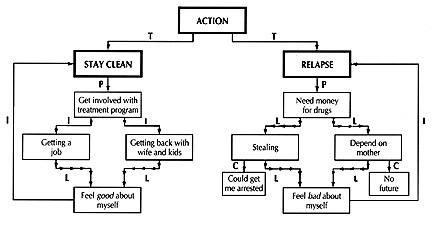Node-link mapping is a way of putting ideas down on paper that makes it easier for drug abuse treatment patients to see and understand the various aspects of a particular problem. Counselors and patients create a map by writing down thoughts, feelings, or actions that they are going to explore in a counseling session and drawing rectangles or ovals around them. Counselors and patients work together to develop the map sequentially, node by node, using "links" to connect the nodes.
In the illustration shown below, the map begins with two possible types (T) of "action" that patients can take during drug abuse treatment: "stay clean" or "relapse." Links are depicted by arrows that display the relationship of the thought, feeling, or action in one node to that in the succeeding node. Here, the participants decided that one "part" (P) or element of staying clean could be to get involved in the treatment program. In turn, involvement in treatment could influence (I) subsequent actions, such as "getting a job" that could lead (L) the patient to "feel good about myself." In turn, this positive feeling could influence the patient to continue to stay clean.

On the other hand, the participants indicated that "relapse" could initiate a cascade of negative consequences that include actions, such as "stealing," that are characterized by such circumstances (C) as getting arrested or a life with no future. In turn, this could lead the patient to "feel bad about myself," which could influence the patient to relapse again.
Working collaboratively in this way, counselors and patients discuss and display alternative actions, paths, and consequences, creating a comprehensive picture that enables patients to see the way to positive solutions as well as the likely negative consequences of taking alternative actions.
Source
- Dees, S.M.; Dansereau, D.F.; and Simpson, D.D. A visual representation system for drug abuse counselors. Journal of Substance Abuse Treatment 11(6): 517-523, 1994.
